Unit 10 if you go to the party, you’ll have a great time. Section B(2a-2c)说课比赛课件(PPT35张)
文档属性
| 名称 | Unit 10 if you go to the party, you’ll have a great time. Section B(2a-2c)说课比赛课件(PPT35张) |  | |
| 格式 | zip | ||
| 文件大小 | 1.1MB | ||
| 资源类型 | 教案 | ||
| 版本资源 | 人教新目标(Go for it)版 | ||
| 科目 | 英语 | ||
| 更新时间 | 2016-09-16 00:25:58 | ||
图片预览

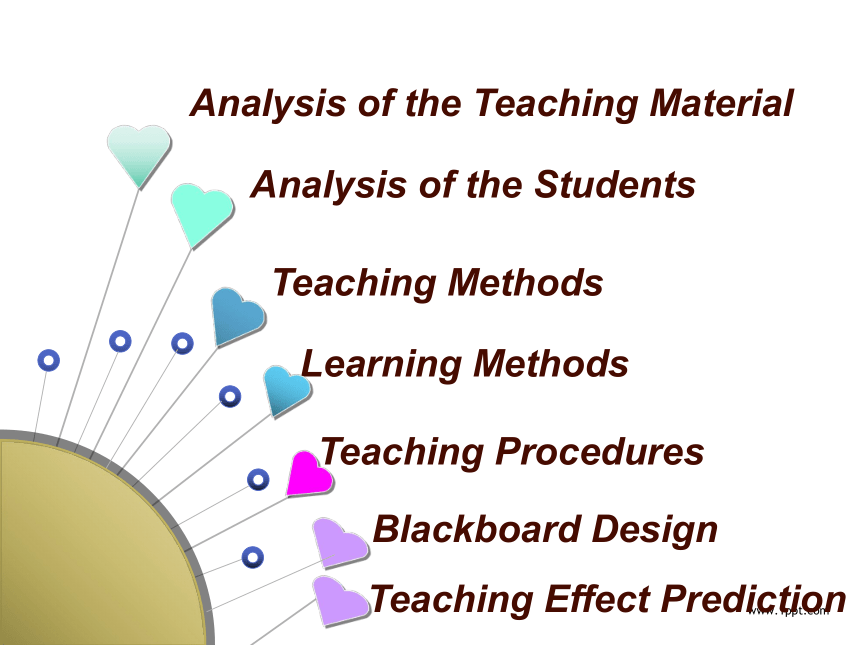
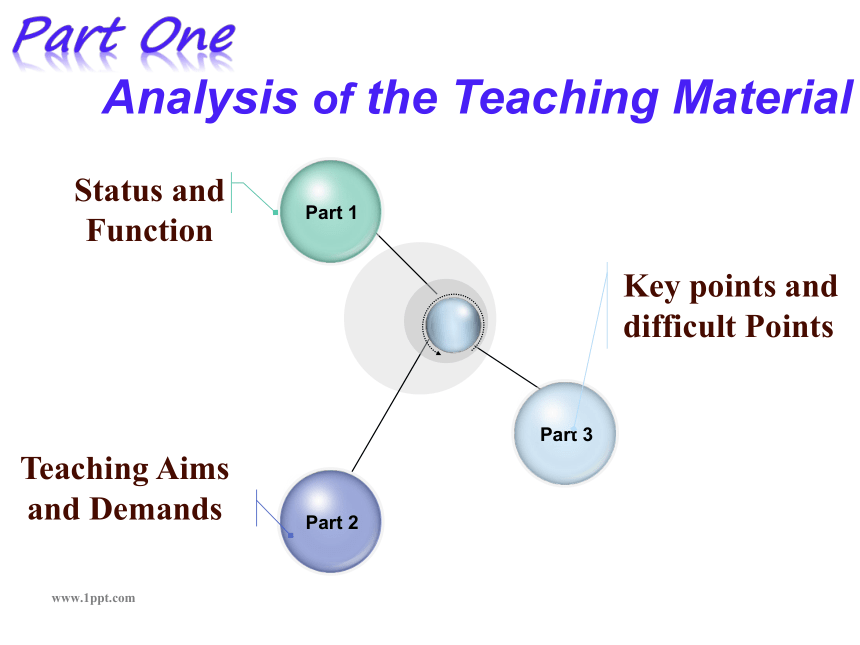


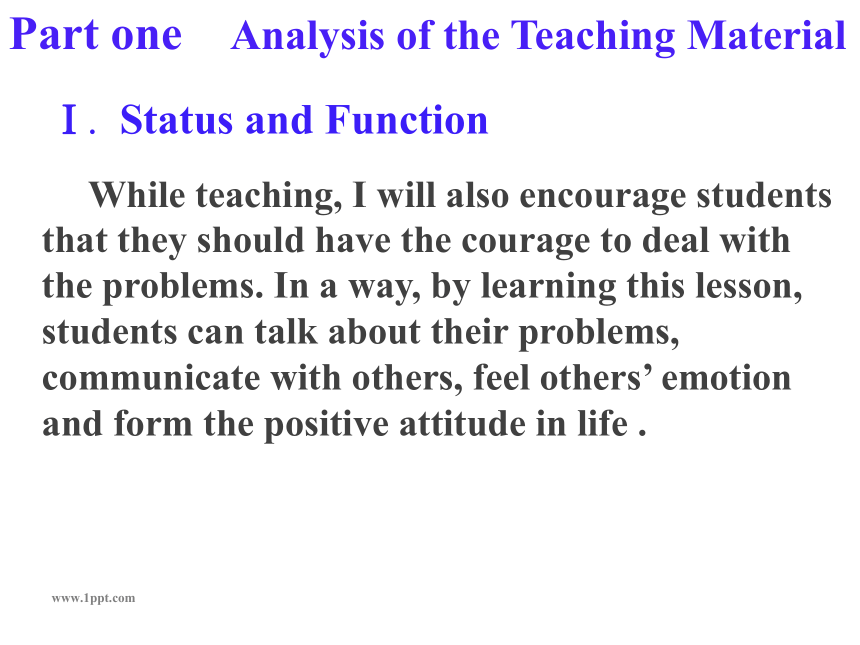
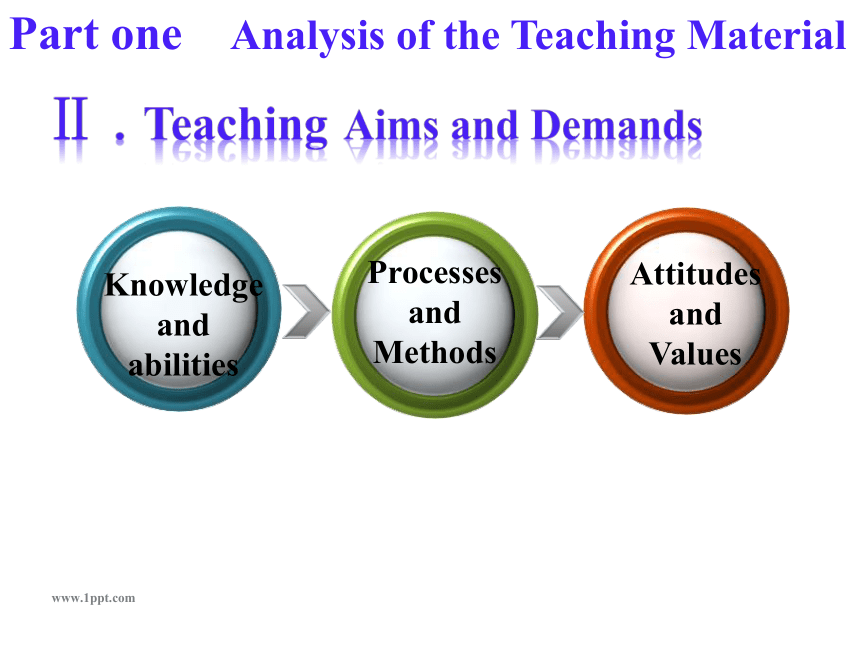
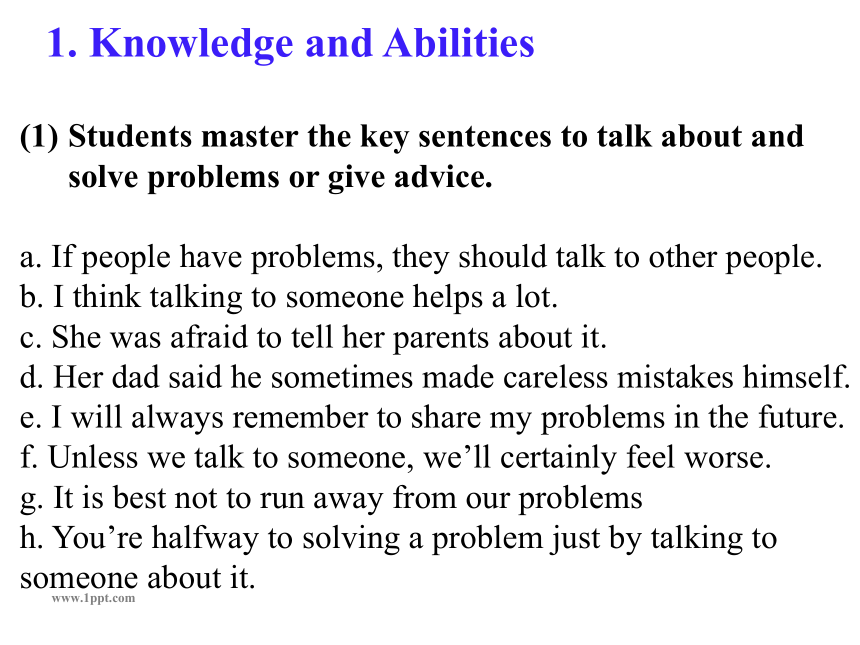
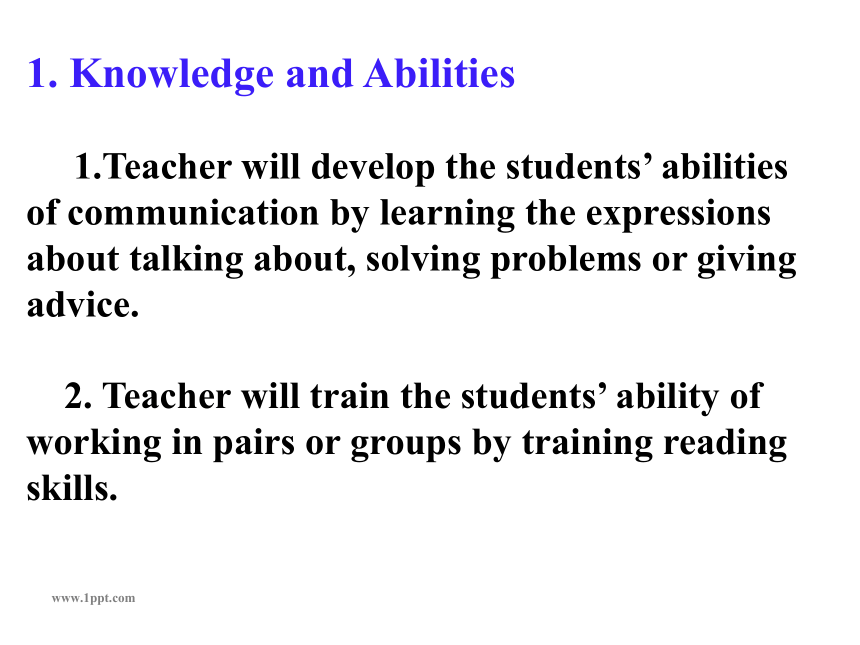
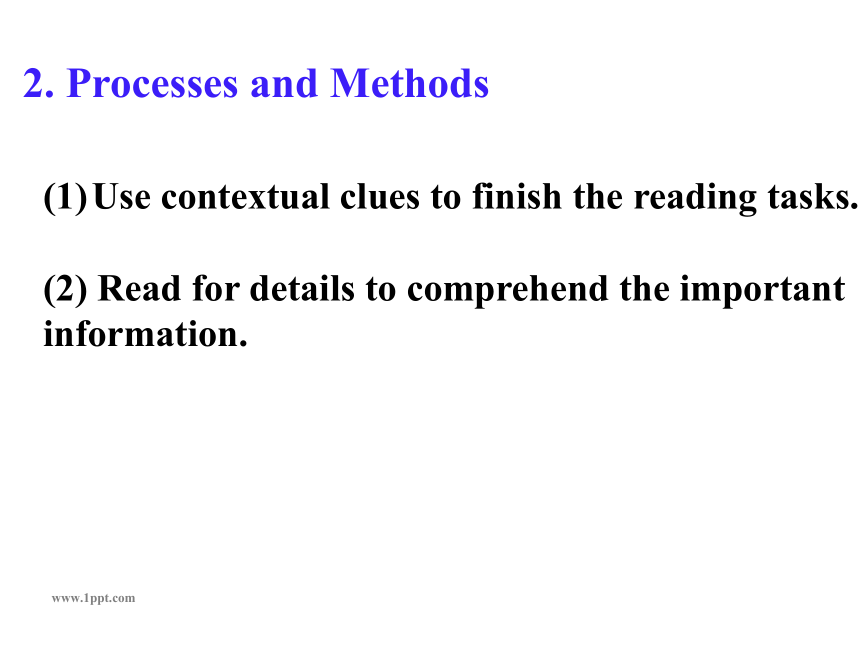
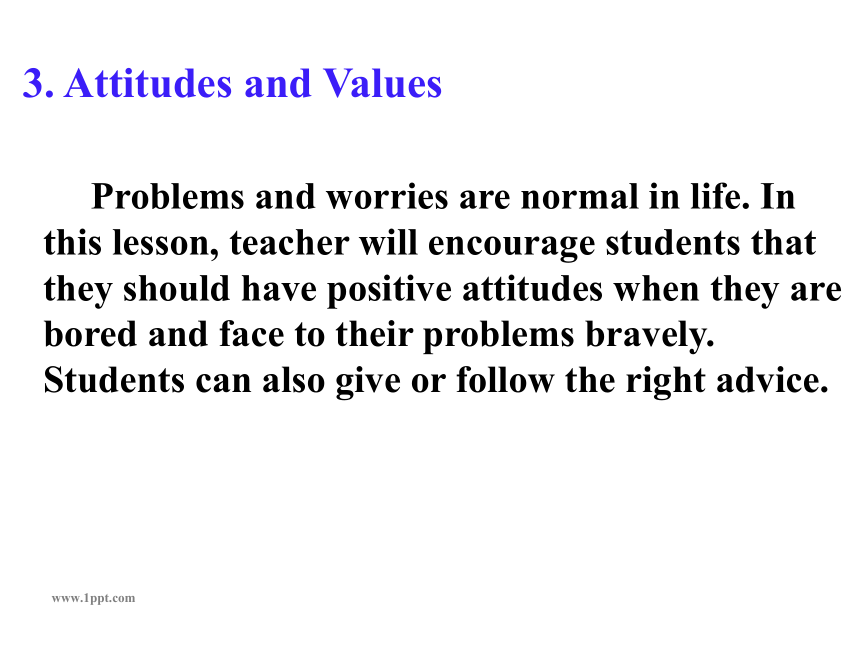
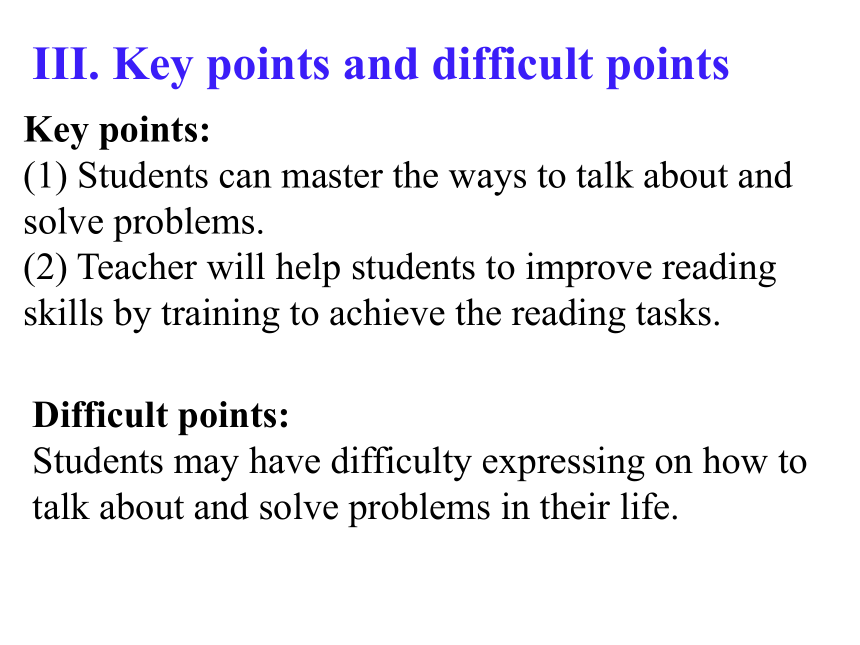
文档简介
课件35张PPT。Unit 10 If you go to the party, you’ll have a great time.Section B(2a-2c)www.1ppt.comTeaching MethodsLearning MethodsTeaching ProceduresAnalysis of the Teaching Material Blackboard DesignAnalysis of the StudentsTeaching Effect Predictionwww.1ppt.comPart OneKey points and difficult PointsTeaching Aims and Demands
Status and FunctionAnalysis of the Teaching Materialwww.1ppt.com This unit has five periods. And this period is a reading lesson. It’s the fourth period of Unit 10. It’s about the topic “What can we do if we have problems?” This topic is related to our daily life because everyone might have some problems in life.
Part one Analysis of the Teaching Material
I . Status and Functionwww.1ppt.com Before this lesson, we have learned Simple Future Tense in Unit 8 in this book and Simple Present Tense ,Simple Past Tense in Grade Seven. We have also learned if conditional adverbial clause and how to give advice from period 1 to period 3 in this unit. That makes students learn this lesson easily.
Part one Analysis of the Teaching Material
I . Status and Functionwww.1ppt.com While teaching, I will also encourage students that they should have the courage to deal with the problems. In a way, by learning this lesson, students can talk about their problems, communicate with others, feel others’ emotion and form the positive attitude in life .
Part one Analysis of the Teaching Material
I . Status and Functionwww.1ppt.comⅡ . Teaching Aims and DemandsKnowledge and abilities
Processes and Methods
Attitudes and Values
Part one Analysis of the Teaching Material
www.1ppt.com1. Knowledge and Abilities
Students master the key sentences to talk about and solve problems or give advice.
a. If people have problems, they should talk to other people.
b. I think talking to someone helps a lot.
c. She was afraid to tell her parents about it.
d. Her dad said he sometimes made careless mistakes himself.
e. I will always remember to share my problems in the future.
f. Unless we talk to someone, we’ll certainly feel worse.
g. It is best not to run away from our problems
h. You’re halfway to solving a problem just by talking to someone about it.www.1ppt.com 1.Teacher will develop the students’ abilities of communication by learning the expressions about talking about, solving problems or giving advice.
2. Teacher will train the students’ ability of working in pairs or groups by training reading skills.1. Knowledge and Abilitieswww.1ppt.com2. Processes and MethodsUse contextual clues to finish the reading tasks.
(2) Read for details to comprehend the important information.www.1ppt.com3. Attitudes and Values Problems and worries are normal in life. In this lesson, teacher will encourage students that they should have positive attitudes when they are bored and face to their problems bravely. Students can also give or follow the right advice. III. Key points and difficult points
Key points:
(1) Students can master the ways to talk about and solve problems.
(2) Teacher will help students to improve reading skills by training to achieve the reading tasks.Difficult points:
Students may have difficulty expressing on how to talk about and solve problems in their life.Part Two Analysis of the Students Students have learned Simple Future Tense in Unit 7 in this book and Simple Present Tense ,Simple Past Tense in Grade Seven. students have also learned how to give advice from period 1 to period 3 in this unit. So it’s easier for them to understand this lesson.
However, their English learning levels are different. Most of them are lack of knowledge to express what to do when they have problems. And poor oral English also makes students communicate with others difficultly.Part Three Teaching Methods
1.According to the new course standard of English (1) Audio-visual teaching method
(2) Task-based teaching method
(3) Communicative teaching method
In this lesson, first I will use the Audio-visual teaching method in step one lead-in. Then I will use task-based teaching method in Teaching procedures to finish reading. In the end, I will use communicative teaching method in the parts of lead-in, careful reading and report.www.1ppt.com2. Teaching Aids blackboard, paper, multi-media computer
www.1ppt.comPart Four Learning Methods(1)self-learning (2)pairwork
(3)groupwork (4)competition
Step 5 Summary(3mins)Step 1 Lead-in(3mins)Step 2 Pre-reading(5mins)Step 3 While-reading
(18mins)Step 4 Post-reading
(4mins)Step 1 skimmingTask: Retelling (pairwork)Step 2 scanningStep 3 careful readingStep 6 Consolidation (6min)Part Five Teaching ProceduresStep 7 Homework (1min)Task: Report (Groupwork)www.1ppt.comStep One lead-in (3mins)a First, Students watch a video about conversation about losing my wallet. This topic is about me. Usually, students and I are not only the relationship between teachers and students but also friends. So this topic can raise our learning interests of students.
After watching the video, I will ask students questions.
Q: What problems does Miss Liu have in the video? What do you think I should do? Can you give me some advice?
(Students can give me some easy advice actively.) Purpose: lead into this lesson naturally and it’s the basis of the last step.www.1ppt.comStep Two Pre-reading (5mins)a In our life, problems and worries are normal.
Now can you tell me what kinds of things you worry about? Who do you usually go to for help?
( Students will discuss in group of 8 and write down their problems and worries on the paper and then hand in.)
Purpose: lead to the topic of this lesson and it makes the clues to Step Four post-reading.Step Three While-reading (18mins)2b Look at the statements and then read the passage quickly. Which statement expresses the main idea of the passage?1. Skimming (2mins)____a. if people have problems, they should get advice from an except.
____b. if people have problems, they should talk to other people,
____c. if people have problems, they should try to keep them to themselves. Students these days often have a lot of worries. Sometimes they have problems with their schoolwork, and sometimes with their friends. What can they do about this? Some people believe the worst thing is to do nothing. Laura Mills, a teenager from London, agrees “Problems and worries are normal in life,” says Laura. “But I think talking to someone helps a lot. Unless we talk to someone, we’ll certainly feel worse.”,Laura once lost her wallet, and worried for days. She was afraid to tell her parents about it. She even walked three miles to school each day because she didn’t have any money. She just kept thinking, “if I tell my parents, they’ll be angry!” in the end, she talked to her parents and they were really understanding. Her dad said he sometimes made careless mistakes himself. They got her a new wallet and asked her to be more careful. “I will always remember to share my problems in the future!” Laura says.Robot Hunt advises students about common problems. He feels the same ways as Laura. “It is best not to run away from our problems. We should always try to solve them.” He thinks the first step is to find someone you trust to talk to. This person doesn’t need to be an expert like himself. Students often forget that their parents have more experience than them, and are always there to them. In English, we say that sharing a problem is like cutting it in half. So you’re halfway to solving a problem just by talking to someone about it!
Purpose: It helps students catch the main idea of the passage quickly to improve skimming skill.Step Three While-reading (18mins)2c Read the passage again and answer the questions. Discuss your answers with a partner.
1.What is the worst thing to do if you have a problem?
2.Why didn’t Laura want to tell her parents about her lost wallet?
3.What is the first thing you should do when you want to solve a problem?
4.Why can our parents give us good advice about our problems?2. Scanning (5mins) Students these days often have a lot of worries. Sometimes they have problems with their schoolwork, and sometimes with their friends. What can they do about this? Some people believe the worst thing is to do nothing. Laura Mills, a teenager from London, agrees “Problems and worries are normal in life,” says Laura. “But I think talking to someone helps a lot. Unless we talk to someone, we’ll certainly feel worse.”,Laura once lost her wallet, and worried for days. She was afraid to tell her parents about it. She even walked three miles to school each day because she didn’t have any money. She just kept thinking, “if I tell my parents, they’ll be angry!” in the end, she talked to her parents and they were really understanding. Her dad said he sometimes made careless mistakes himself. They got her a new wallet and asked her to be more careful. “I will always remember to share my problems in the future!” Laura says.Robot Hunt advises students about common problems. He feels the same ways as Laura. “It is best not to run away from our problems. We should always try to solve them.” He thinks the first step is to find someone you trust to talk to. This person doesn’t need to be an expert like himself. Students often forget that their parents have more experience than them, and are always there to them. In English, we say that sharing a problem is like cutting it in half. So you’re halfway to solving a problem just by talking to someone about it!
Purpose: Students can find the answers quickly with some key phrases or sentences, not read word by word, sentence by sentence.Step Three While-reading (18mins)TASK ONE : Answer the following questions with T/F.
(1)The best thing is to do nothing when we have problems.
(2)Laura thinks talking to someone helps a lot.
(3)Laura’s father was so angry that he didn’t buy her a new wallet.
(4)Robert Hunt agrees with Laura about the way to solve the problem.3. Careful reading (11mins) Students these days often have a lot of worries. Sometimes they have problems with their schoolwork, and sometimes with their friends. What can they do about this? Some people believe the worst thing is to do nothing. Laura Mills, a teenager from London, agrees “Problems and worries are normal in life,” says Laura. “But I think talking to someone helps a lot. Unless we talk to someone, we’ll certainly feel worse.”,Laura once lost her wallet, and worried for days. She was afraid to tell her parents about it. She even walked three miles to school each day because she didn’t have any money. She just kept thinking, “if I tell my parents, they’ll be angry!” in the end, she talked to her parents and they were really understanding. Her dad said he sometimes made careless mistakes himself. They got her a new wallet and asked her to be more careful. “I will always remember to share my problems in the future!” Laura says.Robot Hunt advises students about common problems. He feels the same ways as Laura. “It is best not to run away from our problems. We should always try to solve them.” He thinks the first step is to find someone you trust to talk to. This person doesn’t need to be an expert like himself. Students often forget that their parents have more experience than them, and are always there to them. In English, we say that sharing a problem is like cutting it in half. So you’re halfway to solving a problem just by talking to someone about it!
Purpose : Students can find the right information with careful reading.www.1ppt.comTASK TWO: Read the passage more carefully and underline the key phrases or sentences in this lesson.(6mins)
(Discuss in your group and solve the difficulties about them and then teacher will help to explain the most important or difficult one.) Students these days often have a lot of worries. Sometimes they have problems with their schoolwork, and sometimes with their friends. What can they do about this? Some people believe the worst thing is to do nothing. Laura Mills, a teenager from London, agrees “Problems and worries are normal in life,” says Laura. “But I think talking to someone helps a lot. Unless we talk to someone, we’ll certainly feel worse.”,Laura once lost her wallet, and worried for days. She was afraid to tell her parents about it. She even walked three miles to school each day because she didn’t have any money. She just kept thinking, “if I tell my parents, they’ll be angry!” in the end, she talked to her parents and they were really understanding. Her dad said he sometimes made careless mistakes himself. They got her a new wallet and asked her to be more careful. “I will always remember to share my problems in the future!” Laura says.Robot Hunt advises students about common problems. He feels the same ways as Laura. “It is best not to run away from our problems. We should always try to solve them.” He thinks the first step is to find someone you trust to talk to. This person doesn’t need to be an expert like himself. Students often forget that their parents have more experience than them, and are always there to them. In English, we say that sharing a problem is like cutting it in half. So you’re halfway to solving a problem just by talking to someone about it!
unless除非,引导条件状语从句,相当于if notbe halfway to doing sth.It’s +adj.+not to do sth.Memory Challenge (Students will do it by competition)
1. Translate the phrases and sentences into English.
建议某人关于某事
一分为二
保守秘密
从某人处获得建议
在某方面有困难
一直做某事
做某事成功一半了
如果我们学习上有困难的话,我们应该跟其他人谈谈。
____ we have _______ ______ schoolwork, we should______ _____ _____ people.
(9)除非我们跟别人说,否则我们可能会感到更糟糕。
_____ we talk to someone, we_____ certainly feel worse.
=______ we_______ talk to someone, we _____ certainly feel worse.
(10)与别人交流就意味着解决了一半烦恼。
You’re _____ _____ _____ a problem just _____ _____ to someone about it. Purpose: Students can learn the main knowledge by self-learning and cooperation .Step Four Post-reading (4mins)TASK : Retell the passage (discuss with your partner and check the answers) Students often have a lot of problems and worries. Laura Mills thinks the worst thing is to do _____. She thinks ______ to someone can help her a lot. She thinks you’ll feel worse ______you talk to someone about your problems. Laura remembers that she once lost her _____ and was afraid to tell her parents because they might be angry. After her father knew, he said he sometimes made _______ mistakes himself. So he bought her a new wallet. Robert Hunt agrees with Laura. He thinks you should not run______ from your problems, but you should try to solve them. If you cannot talk to an expert ______ Robert, you can talk with your parents, because they have a lot of ________.www.1ppt.comStep Five Summary (3mins)Students make a list of the key sentences to talk about and solve problems or give advice.a. If people have problems, they should talk to other people.
b. I think talking to someone helps a lot.
c. She was afraid to tell her parents about it.
d. Her dad said he sometimes made careless mistakes himself.
e. I will always remember to share my problems in the future.
f. Unless we talk to someone, we’ll certainly feel worse.
g. It is best not to run away from our problems
h. You’re halfway to solving a problem just by talking to someone about it. Purpose: Sum up the key sentences and it’s the basis of the next step.Make a report
Each leader of groups will choose one of the problems what students have written down on the paper in the part of Step one lead-in. Then discuss in the group around what they have chosen. After discussing, each group will make a report to talk about their problems and how to solve them. Purpose: Consolidate this passage better and use the information what they have learned .Step Six Consolidation (6mins)www.1ppt.comStep Seven HomeworkWrite a passage to talk about your own problems and how to solve them about 70 words.
Part Six Blackboard Design
Unit 10 If you go to the party, you’ll have a great timeSection B (2a-2c)Important Sentences:a. If people have problems, they should talk to other people.
b. I think talking to someone helps a lot.
c. She was afraid to tell her parents about it.
d. Her dad said he sometimes made careless mistakes himself.
e. I will always remember to share my problems in the future.
f. Unless we talk to someone, we’ll certainly feel worse.
g. It is best not to run away from our problems
h. You’re halfway to solving a problem just by talking to someone about it.www.1ppt.com This lesson should be successful. Problems and worries are very normal in life. So it’s related to our daily life. Of course, students will be interested in it. They also want to solve them in right ways. But they don’t know how to solve them rightly. Some students may run away, some may face them bravely. So in this class, how to encourage them to say out and how to solve their problems bravely may be difficult.
Part Seven Teaching Effect Prediction
Thank you!
Status and FunctionAnalysis of the Teaching Materialwww.1ppt.com This unit has five periods. And this period is a reading lesson. It’s the fourth period of Unit 10. It’s about the topic “What can we do if we have problems?” This topic is related to our daily life because everyone might have some problems in life.
Part one Analysis of the Teaching Material
I . Status and Functionwww.1ppt.com Before this lesson, we have learned Simple Future Tense in Unit 8 in this book and Simple Present Tense ,Simple Past Tense in Grade Seven. We have also learned if conditional adverbial clause and how to give advice from period 1 to period 3 in this unit. That makes students learn this lesson easily.
Part one Analysis of the Teaching Material
I . Status and Functionwww.1ppt.com While teaching, I will also encourage students that they should have the courage to deal with the problems. In a way, by learning this lesson, students can talk about their problems, communicate with others, feel others’ emotion and form the positive attitude in life .
Part one Analysis of the Teaching Material
I . Status and Functionwww.1ppt.comⅡ . Teaching Aims and DemandsKnowledge and abilities
Processes and Methods
Attitudes and Values
Part one Analysis of the Teaching Material
www.1ppt.com1. Knowledge and Abilities
Students master the key sentences to talk about and solve problems or give advice.
a. If people have problems, they should talk to other people.
b. I think talking to someone helps a lot.
c. She was afraid to tell her parents about it.
d. Her dad said he sometimes made careless mistakes himself.
e. I will always remember to share my problems in the future.
f. Unless we talk to someone, we’ll certainly feel worse.
g. It is best not to run away from our problems
h. You’re halfway to solving a problem just by talking to someone about it.www.1ppt.com 1.Teacher will develop the students’ abilities of communication by learning the expressions about talking about, solving problems or giving advice.
2. Teacher will train the students’ ability of working in pairs or groups by training reading skills.1. Knowledge and Abilitieswww.1ppt.com2. Processes and MethodsUse contextual clues to finish the reading tasks.
(2) Read for details to comprehend the important information.www.1ppt.com3. Attitudes and Values Problems and worries are normal in life. In this lesson, teacher will encourage students that they should have positive attitudes when they are bored and face to their problems bravely. Students can also give or follow the right advice. III. Key points and difficult points
Key points:
(1) Students can master the ways to talk about and solve problems.
(2) Teacher will help students to improve reading skills by training to achieve the reading tasks.Difficult points:
Students may have difficulty expressing on how to talk about and solve problems in their life.Part Two Analysis of the Students Students have learned Simple Future Tense in Unit 7 in this book and Simple Present Tense ,Simple Past Tense in Grade Seven. students have also learned how to give advice from period 1 to period 3 in this unit. So it’s easier for them to understand this lesson.
However, their English learning levels are different. Most of them are lack of knowledge to express what to do when they have problems. And poor oral English also makes students communicate with others difficultly.Part Three Teaching Methods
1.According to the new course standard of English (1) Audio-visual teaching method
(2) Task-based teaching method
(3) Communicative teaching method
In this lesson, first I will use the Audio-visual teaching method in step one lead-in. Then I will use task-based teaching method in Teaching procedures to finish reading. In the end, I will use communicative teaching method in the parts of lead-in, careful reading and report.www.1ppt.com2. Teaching Aids blackboard, paper, multi-media computer
www.1ppt.comPart Four Learning Methods(1)self-learning (2)pairwork
(3)groupwork (4)competition
Step 5 Summary(3mins)Step 1 Lead-in(3mins)Step 2 Pre-reading(5mins)Step 3 While-reading
(18mins)Step 4 Post-reading
(4mins)Step 1 skimmingTask: Retelling (pairwork)Step 2 scanningStep 3 careful readingStep 6 Consolidation (6min)Part Five Teaching ProceduresStep 7 Homework (1min)Task: Report (Groupwork)www.1ppt.comStep One lead-in (3mins)a First, Students watch a video about conversation about losing my wallet. This topic is about me. Usually, students and I are not only the relationship between teachers and students but also friends. So this topic can raise our learning interests of students.
After watching the video, I will ask students questions.
Q: What problems does Miss Liu have in the video? What do you think I should do? Can you give me some advice?
(Students can give me some easy advice actively.) Purpose: lead into this lesson naturally and it’s the basis of the last step.www.1ppt.comStep Two Pre-reading (5mins)a In our life, problems and worries are normal.
Now can you tell me what kinds of things you worry about? Who do you usually go to for help?
( Students will discuss in group of 8 and write down their problems and worries on the paper and then hand in.)
Purpose: lead to the topic of this lesson and it makes the clues to Step Four post-reading.Step Three While-reading (18mins)2b Look at the statements and then read the passage quickly. Which statement expresses the main idea of the passage?1. Skimming (2mins)____a. if people have problems, they should get advice from an except.
____b. if people have problems, they should talk to other people,
____c. if people have problems, they should try to keep them to themselves. Students these days often have a lot of worries. Sometimes they have problems with their schoolwork, and sometimes with their friends. What can they do about this? Some people believe the worst thing is to do nothing. Laura Mills, a teenager from London, agrees “Problems and worries are normal in life,” says Laura. “But I think talking to someone helps a lot. Unless we talk to someone, we’ll certainly feel worse.”,Laura once lost her wallet, and worried for days. She was afraid to tell her parents about it. She even walked three miles to school each day because she didn’t have any money. She just kept thinking, “if I tell my parents, they’ll be angry!” in the end, she talked to her parents and they were really understanding. Her dad said he sometimes made careless mistakes himself. They got her a new wallet and asked her to be more careful. “I will always remember to share my problems in the future!” Laura says.Robot Hunt advises students about common problems. He feels the same ways as Laura. “It is best not to run away from our problems. We should always try to solve them.” He thinks the first step is to find someone you trust to talk to. This person doesn’t need to be an expert like himself. Students often forget that their parents have more experience than them, and are always there to them. In English, we say that sharing a problem is like cutting it in half. So you’re halfway to solving a problem just by talking to someone about it!
Purpose: It helps students catch the main idea of the passage quickly to improve skimming skill.Step Three While-reading (18mins)2c Read the passage again and answer the questions. Discuss your answers with a partner.
1.What is the worst thing to do if you have a problem?
2.Why didn’t Laura want to tell her parents about her lost wallet?
3.What is the first thing you should do when you want to solve a problem?
4.Why can our parents give us good advice about our problems?2. Scanning (5mins) Students these days often have a lot of worries. Sometimes they have problems with their schoolwork, and sometimes with their friends. What can they do about this? Some people believe the worst thing is to do nothing. Laura Mills, a teenager from London, agrees “Problems and worries are normal in life,” says Laura. “But I think talking to someone helps a lot. Unless we talk to someone, we’ll certainly feel worse.”,Laura once lost her wallet, and worried for days. She was afraid to tell her parents about it. She even walked three miles to school each day because she didn’t have any money. She just kept thinking, “if I tell my parents, they’ll be angry!” in the end, she talked to her parents and they were really understanding. Her dad said he sometimes made careless mistakes himself. They got her a new wallet and asked her to be more careful. “I will always remember to share my problems in the future!” Laura says.Robot Hunt advises students about common problems. He feels the same ways as Laura. “It is best not to run away from our problems. We should always try to solve them.” He thinks the first step is to find someone you trust to talk to. This person doesn’t need to be an expert like himself. Students often forget that their parents have more experience than them, and are always there to them. In English, we say that sharing a problem is like cutting it in half. So you’re halfway to solving a problem just by talking to someone about it!
Purpose: Students can find the answers quickly with some key phrases or sentences, not read word by word, sentence by sentence.Step Three While-reading (18mins)TASK ONE : Answer the following questions with T/F.
(1)The best thing is to do nothing when we have problems.
(2)Laura thinks talking to someone helps a lot.
(3)Laura’s father was so angry that he didn’t buy her a new wallet.
(4)Robert Hunt agrees with Laura about the way to solve the problem.3. Careful reading (11mins) Students these days often have a lot of worries. Sometimes they have problems with their schoolwork, and sometimes with their friends. What can they do about this? Some people believe the worst thing is to do nothing. Laura Mills, a teenager from London, agrees “Problems and worries are normal in life,” says Laura. “But I think talking to someone helps a lot. Unless we talk to someone, we’ll certainly feel worse.”,Laura once lost her wallet, and worried for days. She was afraid to tell her parents about it. She even walked three miles to school each day because she didn’t have any money. She just kept thinking, “if I tell my parents, they’ll be angry!” in the end, she talked to her parents and they were really understanding. Her dad said he sometimes made careless mistakes himself. They got her a new wallet and asked her to be more careful. “I will always remember to share my problems in the future!” Laura says.Robot Hunt advises students about common problems. He feels the same ways as Laura. “It is best not to run away from our problems. We should always try to solve them.” He thinks the first step is to find someone you trust to talk to. This person doesn’t need to be an expert like himself. Students often forget that their parents have more experience than them, and are always there to them. In English, we say that sharing a problem is like cutting it in half. So you’re halfway to solving a problem just by talking to someone about it!
Purpose : Students can find the right information with careful reading.www.1ppt.comTASK TWO: Read the passage more carefully and underline the key phrases or sentences in this lesson.(6mins)
(Discuss in your group and solve the difficulties about them and then teacher will help to explain the most important or difficult one.) Students these days often have a lot of worries. Sometimes they have problems with their schoolwork, and sometimes with their friends. What can they do about this? Some people believe the worst thing is to do nothing. Laura Mills, a teenager from London, agrees “Problems and worries are normal in life,” says Laura. “But I think talking to someone helps a lot. Unless we talk to someone, we’ll certainly feel worse.”,Laura once lost her wallet, and worried for days. She was afraid to tell her parents about it. She even walked three miles to school each day because she didn’t have any money. She just kept thinking, “if I tell my parents, they’ll be angry!” in the end, she talked to her parents and they were really understanding. Her dad said he sometimes made careless mistakes himself. They got her a new wallet and asked her to be more careful. “I will always remember to share my problems in the future!” Laura says.Robot Hunt advises students about common problems. He feels the same ways as Laura. “It is best not to run away from our problems. We should always try to solve them.” He thinks the first step is to find someone you trust to talk to. This person doesn’t need to be an expert like himself. Students often forget that their parents have more experience than them, and are always there to them. In English, we say that sharing a problem is like cutting it in half. So you’re halfway to solving a problem just by talking to someone about it!
unless除非,引导条件状语从句,相当于if notbe halfway to doing sth.It’s +adj.+not to do sth.Memory Challenge (Students will do it by competition)
1. Translate the phrases and sentences into English.
建议某人关于某事
一分为二
保守秘密
从某人处获得建议
在某方面有困难
一直做某事
做某事成功一半了
如果我们学习上有困难的话,我们应该跟其他人谈谈。
____ we have _______ ______ schoolwork, we should______ _____ _____ people.
(9)除非我们跟别人说,否则我们可能会感到更糟糕。
_____ we talk to someone, we_____ certainly feel worse.
=______ we_______ talk to someone, we _____ certainly feel worse.
(10)与别人交流就意味着解决了一半烦恼。
You’re _____ _____ _____ a problem just _____ _____ to someone about it. Purpose: Students can learn the main knowledge by self-learning and cooperation .Step Four Post-reading (4mins)TASK : Retell the passage (discuss with your partner and check the answers) Students often have a lot of problems and worries. Laura Mills thinks the worst thing is to do _____. She thinks ______ to someone can help her a lot. She thinks you’ll feel worse ______you talk to someone about your problems. Laura remembers that she once lost her _____ and was afraid to tell her parents because they might be angry. After her father knew, he said he sometimes made _______ mistakes himself. So he bought her a new wallet. Robert Hunt agrees with Laura. He thinks you should not run______ from your problems, but you should try to solve them. If you cannot talk to an expert ______ Robert, you can talk with your parents, because they have a lot of ________.www.1ppt.comStep Five Summary (3mins)Students make a list of the key sentences to talk about and solve problems or give advice.a. If people have problems, they should talk to other people.
b. I think talking to someone helps a lot.
c. She was afraid to tell her parents about it.
d. Her dad said he sometimes made careless mistakes himself.
e. I will always remember to share my problems in the future.
f. Unless we talk to someone, we’ll certainly feel worse.
g. It is best not to run away from our problems
h. You’re halfway to solving a problem just by talking to someone about it. Purpose: Sum up the key sentences and it’s the basis of the next step.Make a report
Each leader of groups will choose one of the problems what students have written down on the paper in the part of Step one lead-in. Then discuss in the group around what they have chosen. After discussing, each group will make a report to talk about their problems and how to solve them. Purpose: Consolidate this passage better and use the information what they have learned .Step Six Consolidation (6mins)www.1ppt.comStep Seven HomeworkWrite a passage to talk about your own problems and how to solve them about 70 words.
Part Six Blackboard Design
Unit 10 If you go to the party, you’ll have a great timeSection B (2a-2c)Important Sentences:a. If people have problems, they should talk to other people.
b. I think talking to someone helps a lot.
c. She was afraid to tell her parents about it.
d. Her dad said he sometimes made careless mistakes himself.
e. I will always remember to share my problems in the future.
f. Unless we talk to someone, we’ll certainly feel worse.
g. It is best not to run away from our problems
h. You’re halfway to solving a problem just by talking to someone about it.www.1ppt.com This lesson should be successful. Problems and worries are very normal in life. So it’s related to our daily life. Of course, students will be interested in it. They also want to solve them in right ways. But they don’t know how to solve them rightly. Some students may run away, some may face them bravely. So in this class, how to encourage them to say out and how to solve their problems bravely may be difficult.
Part Seven Teaching Effect Prediction
Thank you!
同课章节目录
- Unit 1 Where did you go on vacation?
- Section A
- Section B
- Unit 2 How often do you exercise?
- Section A
- Section B
- Unit 3 I'm more outgoing than my sister.
- Section A
- Section B
- Unit 4 What's the best movie theater?
- Section A
- Section B
- Unit 5 Do you want to watch a game show?
- Section A
- Section B
- Unit 6 I'm going to study computer science.
- Section A
- Section B
- Unit 7 Will people have robots?
- Section A
- Section B
- Unit 8 How do you make a banana milk shake?
- Section A
- Section B
- Unit 9 Can you come to my party?
- Section A
- Section B
- Unit 10 If you go to the party, you'll have a grea
- Section A
- Section B
